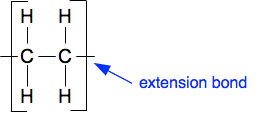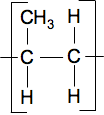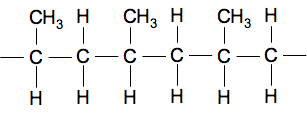|
Chemguide: Core Chemistry 14 - 16 Addition Polymerisation This page is an introduction to addition polymerisation and the formation and structures of common polymers like polythene, PVC and others. I am assuming that you are familiar with alkenes. Poly(ethene) - usually known as polythene Ethene molecules can join up into long chains under industrial conditions:
It is unlikely that you will need to know these conditions. I include them just out of interest and to show that it would be difficult to do this in a school lab!
Half of each double bond is broken, and the electrons are used to join on to other molecules doing the same thing. Very large numbers of CH2-CH2 units can join up in this way. "n" represents that very large number. The ethene is called the monomer and the long product molecule is called a polymer. This sort of polymer is called an addition polymer because lots of molecules have added together with nothing at all being lost in the process. The name of an addition polymer is based on the monomer it came from. The polymer in this case is called poly(ethene) - which just means lots of ethene molecules joined up. It is more commonly called polythene. The bit inside the square brackets in the equation above is called the repeat unit. Notice the way it is drawn in the equation:
It is important to draw the extension bonds passing through the square brackets surrounding the CH2-CH2 group. This makes it clear that the structure continues in the same way along the chain. You run the risk of losing a mark if you don't do that in an exam. Poly(propene) Propene has a 3-carbon chain with a double bond, usually written CH3CH=CH2. Propene does exactly the same thing as ethene. This time you get poly(propene) - usually called by its older name polypropylene. Students asked to draw a bit of the poly(propene) chain often get confused by the presence of the CH3, and can't see how that fits into the main chain. It doesn't! The trick is to imagine propene like this:
. . . so that the repeat unit in the chain looks like this:
. . . and a short bit of chain looks like this:
The chain itself hasn't altered - it is still just a string of singly-bonded carbon atoms. But alternate carbon atoms have a methyl group attached. Poly(chloroethene) - usually called PVC Chloroethene has the formula CH2=CHCl. It used to be called vinyl chloride. The usual abbreviation of PVC comes from PolyVinylChloride. This joins up in the same sort of way as poly(propene):
The repeat unit this time is:
Poly(tetrafluoroethene) - usually called PTFE PTFE is the familiar non-stick coating on saucepans and the like. Tetrafluoroethene is an ethene molecule in which all the hydrogen atoms have been replaced by fluorine atoms, CF2=CF2. The repeat unit looks like this:
You can draw the chain if you want to. It will look just like poly(ethene) except with fluorines attached rather than hydrogens. Addition polymerisation in exams There are two likely questions. Asking you to draw a part of the polymer chain from a given monomer This is basically what we have been doing above, and to save time I will simply use one of those examples. You are told that you can make a polymer from propene, CH3CH=CH2, and are asked to draw a length of poly(propene) chain to include three repeat units. You need to start by drawing the monomer so that all the attachments are kept out of the way of the carbon-carbon double bond.
. . . so that the repeat unit in the chain looks like this:
Now draw a bit of chain with three repeat units because that's what the examiners are asking for.
Don't forget the extension bonds on either end showing that the chain continues beyond this. Asking you to work out the monomer from a given polymer chain All you have to do is to identify a repeating unit with two carbon atoms in the chain. Suppose you were given this bit of chain:
It is pretty obvious that the repeat unit is:
. . . and that will have come from:
You could, of course, have chosen a repeating unit which had the CN group on the left-hand carbon. If you did that, you would get this structure for the monomer:
It looks different, but is actually exactly the same molecule flipped over horizontally. Either answer would be perfectly good. You don't have to worry about which two carbon atoms you choose to work out your repeat unit.
© Jim Clark 2021 |
|||||||












